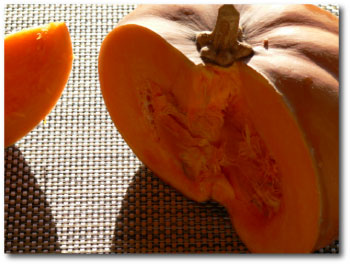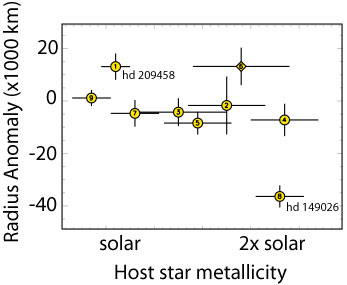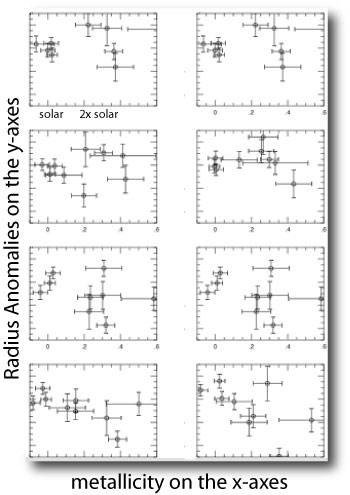
Tristan Guillot and his colleagues have just published a paper, “A correlation between the heavy element content of transiting extrasolar planets and the metallicity of their parent stars” which explores an interesting new hypothesis for resolving the size problem for transiting hot Jupiters.
Readers of oklo.org are well aware that our theoretical understanding of the radii of hot Jupiters isn’t all it could be. For example, the transiting planets TrES-1 and HD 209458 b have very similar masses and surface temperatures, and yet HD 209458 b has a radius that is roughly 25% larger than TrES-1’s. In a previous post (see also this post), we outlined some of the hypotheses that might explain this discrepancy in radii.
Guillot et al’s idea is that the mass of a planetary core is a very steep function of stellar metallicity. That is, doubling the metallicity of the parent star leads to a 5-10 fold increase in the amount of mass contained in the cores of any short-period planets in orbit around the star. Larger core masses lead to smaller overall planetary radii at given mass, and so, in the Guillot et al. picture, planets orbiting metal-rich stars will, in general, be considerably smaller than planets of equal mass orbiting metal poor stars.
They present the following graph to support their hypothesis. It shows the difference in observed planetary size from the baseline theoretical expectation on the y-axis, and the parent star metallicity on the x-axis. They note (and the eye notes) that there is a trend in the diagram; planets orbiting metal-rich stars (as exemplified dramatically by HD 149026b) tend to be smaller than predicted, and planets orbiting stars of near-solar metallicity (e.g. HD 209458b tend to be larger than predicted.

Figure adapted from Guillot et al. 2006.
But is this correlation really present? To get a qualitative sense of whether it is or not, I took the planetary radius and parent star metallicity values for the 9 transiting planets in the Guillot et al plot and redrew them from their implied uncertainty distributions to make alternate, statistically equivalent versions of the plot in their paper. I also made control plots in which I assumed that there is no underlying radius-metallicity effect, only noise from measurement uncertainty. I made four plots of the first variety, and four plots of the second control variety. They are shown below. Can you identify which plots are the control plots?


Pingback: systemic - TrES-2
Pingback: systemic - hot and bothered